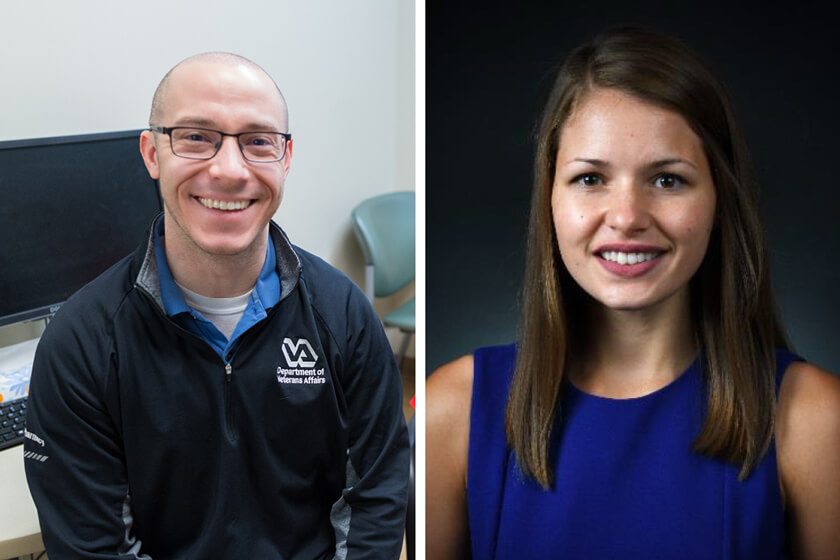Patient-focused research project explores how information can increase epilepsy medication adherence
By Katie Ginder-Vogel
In his clinical pharmacy practice at the William S. Middleton Veterans Affairs Hospital, Barry Gidal regularly works with patients struggling to control their epilepsy.
“Epilepsy is a complex disease, and we have found that patients struggle not only in understanding their various antiseizure drugs, but also the disease themselves,” says Gidal, professor and chair of the University of Wisconsin–Madison School of Pharmacy’s Pharmacy Practice Division. “We have also found that one very important element in ensuring the best outcome possible for any individual patient, is to establish a strong, therapeutic alliance.”
To help patients manage their condition and feel in control of their health care, Gidal is leading a six-month research project to explore the role pharmacist-led patient education can play in medication adherence.
Gidal and Assistant Professor Amanda Margolis (PharmD ’09, MS ’17), also in the Pharmacy Practice Division, are working with the global pharmaceutical company UCB on the project as part of a larger study testing interventions to improve patient outcomes through encouraging adherence. Because of his research renown, UCB approached Gidal with the proposal.
“Over the years, I have seen a number of companies, as well as patient advocacy groups, develop patient education materials. Typically, these consist of very basic brochures describing either a specific drug, or perhaps seizure types,” says Gidal. “The program developed by UCB is novel in that it is specifically designed to foster an ongoing conversation with the pharmacist regarding both disease and treatments. Importantly, the pharmacist will be guiding the patient toward developing a sense of mastery over their epilepsy, and self-care.”

Multi-step education
Gidal is the study’s subject matter expert, and Margolis is helping to implement the study, which they anticipate lasting about six months. With help from student pharmacists in the School of Pharmacy’s PharmD program and pharmacy residents at the VA Hospital, the research team will evaluate the implementation of a pharmacist-driven epilepsy education and adherence program in an ambulatory care setting.
Gidal invites his patients to participate in the study during routine epilepsy clinic appointments, and if they agree, they receive five packets of patient-friendly epilepsy education materials to review at home. The information covers important patient education topics regarding epilepsy, which range from basic information about epilepsy and why it occurs to medication management and seizure tracking, both of which can help patients restore a sense of normalcy and predictability in their lives.
“Importantly, the pharmacist will be guiding the patient toward developing a sense of mastery over their epilepsy, and self-care.”
–Barry Gidal
Pharmacy residents Andy Cannon (PharmD ’17) and Magdalena Siodlak (PharmD ’18) initiate a series of follow-up phone conversations to see if patients have any questions and to talk through what they’ve learned.
“All the educational interventions happen remotely, which is huge for our patients, who are all over the state and don’t have to travel to participate,” explains Margolis. “It’s more flexible for both patients and clinicians.”
The calls take place about every two weeks for several months.
“Over the course of five 30-minute phone calls, the patients are able to really get to know their pharmacist and develop a relationship,” says Margolis. “Having an established relationship with your provider is helpful to promote adherence. The education delivered is more in-depth than what is possible during a regular appointment.”
So far, patients have shown a great interest in getting involved with the education program. It’s too early to determine whether interventions like this will reduce the number of seizures or hospitalizations, but those are two of the factors Margolis and Gidal will be evaluating, along with the feasibility and system factors of implementing the intervention. Importantly, the team is also tracking patient satisfaction. For example, patients will be invited to give feedback about the program and the pharmacists with whom they worked.
Cannon encountered a participant who is a former health care worker and already had a strong medical background, who was nonetheless impressed and surprised by what the program taught her.
“She was amazed by all the new things she learned from the modules,” he says. “She said, ‘I am so glad I chose to participate.’”
Cannon says he has learned more about epilepsy as a specialty area and has also practiced new patient care skills.
“Through this project, I was hoping to gain more patient contact experience in an area I was less familiar with and work with patients who have some mental health concerns, as epilepsy can be very emotionally and physically taxing on patients,” he says. “It’s an opportunity to work on patient communication skills, using patient-friendly terminology.”
The research team
In addition to his clinical practice, Gidal studies the use of antiseizure drugs in older adults with epilepsy, as well as in people with traumatic brain injury. He has published numerous research studies, clinical publications and book chapters relating to antiseizure drug pharmacokinetics/pharmacodynamics and drug interactions in adults with epilepsy. Gidal has served on the editorial boards for Epilepsia, Epilepsy Research, Epilepsy & Behavior, Epilepsy Currents and Annals of Pharmacotherapy and is an active member of the American Epilepsy Society and the Epilepsy Foundation.

“Dr. Gidal is well known in the epilepsy community,” says Margolis. “He is an expert in pharmacology and drug management for patients with epilepsy. UCB reached out to him because this fits perfectly with his expertise and clinical practice in the William S. Middleton Memorial Veterans Hospital’s Epilepsy Clinic, which is one of just 16 Epilepsy Centers of Excellence in the nation.”
The research team includes Cannon and Siodlak, the two pharmacy residents who are delivering the educational material; and two students in the School’s PharmD program, Hannah Hecht and Carlie Wilke, who are collecting data.
“The PharmD students assist with data abstraction, where they’re extracting the baseline characteristics out of the medical record and maintaining the study database,” says Margolis. “They might also help mail out and keep track of the final surveys and conduct patient interviews over the phone regarding patient satisfaction with the program, which will give them great experience communicating with patients and understanding their needs.”
Pharmacists as educators
Margolis says the study creates opportunities for research for School of Pharmacy residents and student pharmacists, while studying the opportunity for pharmacists to enhance their role in patient care.
“This is an opportunity to expand the pharmacist’s role,” says Margolis. “The VA is quite progressive for pharmacy practice, and this intervention may offer further evidence on the impact of pharmacist medication education for these patients.”
Cannon agrees, and thinks pharmacists are the perfect health care professionals to provide this personalized service.
“It really solidifies the fact that pharmacists are not only medication experts but can also be educators,” he explains. “We have such strong foundational knowledge that we can easily learn and adapt to new challenges and new information. By guiding patient through these educational materials, we are able to fully assist patients with the questions and concerns they have and make them feel more empowered.”
Learn about another patient-education focused initiative led by Professor Eva Vivian to teach a community about diabetes.